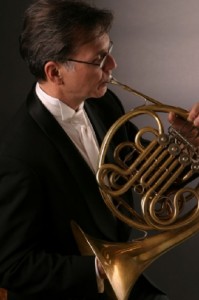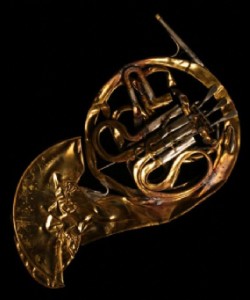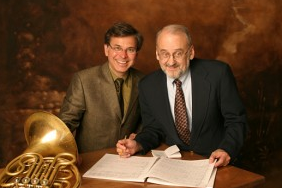A New Horn Concerto: From Concept To Recording – Part 1
 Editor’s Note: This article is enhanced with high quality audio clips designed to let you listen to what you’re reading about. Wherever you see a musical notes icon like the one at the top of this paragraph, click to hear the corresponding audio file (try the one above to see how it works).
Editor’s Note: This article is enhanced with high quality audio clips designed to let you listen to what you’re reading about. Wherever you see a musical notes icon like the one at the top of this paragraph, click to hear the corresponding audio file (try the one above to see how it works).
Ever since I started playing the French Horn, I’ve always wondered about the origin of each new concerto that I’ve encountered. Was it written for a specific performer? Who premiered the piece? Did the composer have a personal relationship with the musician for whom it was written? What was the inspiration for the composer? Where was it first performed? Was it well received? Many questions such as these can be easily answered through historical research.
However, I’ve still always marveled at what it might be like to be in the midst of bringing a new composition to life. I surmised that it must be extremely exciting to experience the process first hand. Eventually, I found myself wondering “How could I create a new concerto?” Well, obviously, I’d need a composer who was inclined to spend the time to write it, a commitment for performances, a lot of money, and time to practice. At that point in the process, the only thing I had from that list was time. As such, commissioning a horn concerto was more of a hopeful dream than a serious project.
Nevertheless, I remained committed to the idea, and by 1983 I had developed contacts that eventually resulted in securing the commission fee and funding for performances. By that same point in time I had also established myself as a professional player and developed a relationship with an excellent composer, so I brought all of these resources together to create what would become known as Horn Concerto.
Finding The Composer
I met Jan Bach in 1974 during my last year of high school while playing as a substitute musician with the Rockford Symphony Orchestra. The following year, as a freshman at Northern Illinois University, I joined the RSO horn section and commuted weekly to Rockford for services. Jan was serving as the Principal Horn of the section at that time and since we lived in the same area, we drove to services together.
We had great conversations during the car trips and consumed copious amounts of fresh cookies as we detoured past my parents’ home before heading back to NIU. I admired Jan on several levels: as a musician, a theory and composition professor, and especially as a gifted composer. Some of Jan’s works which I’ve also personally performed are his Laudes For Brass Quintet  and Four 2-Bit Contraptions
and Four 2-Bit Contraptions .
.
Furthermore, Jan was intimately familiar with the French Horn’s capabilities, was acquainted with my abilities as a horn player, and was (and still is) extremely well respected in the brass community. All of these things led me to feel that Jan was an ideal choice to write my horn concerto.
Developing The Ability & Commitment for Performances

"…being surrounded by the world’s finest voices and playing solo horn in the Lyric Opera of Chicago provided me with a wonderful opportunity to develop as a performer."
While I was a senior at NIU, my teacher, Bill Klingelhoffer, left his position at the Lyric Opera of Chicago to join the Houston Symphony. Gail Williams replaced him at Northern for my final semester. Both Gail and I auditioned for and made the final round for the Chicago Symphony Orchestra horn section. In the end Gail moved over to Orchestra Hall with the CSO and one year later, I auditioned for and replaced her as Principal Horn of the Lyric. Consequently, being surrounded by the world’s finest voices and playing solo horn provided me with a wonderful opportunity to develop as a performer.
As an outgrowth of the Lyric Opera musicians’ desire for a longer season, The Orchestra of Illinois was founded in 1979 as a co-operative orchestra governed by the musicians. For the inaugural season, Jan Bach was commissioned to write Gala Fanfare , which was well received by the audience and critics. Several years later, I knew that I wanted Jan to write a concerto for me, but I still needed the guarantee of at least one performance. I approached the Orchestra of Illinois’ Board of Directors with the idea, and they accepted my proposal. The premiere was planned for the spring of 1983, and my dream had moved from being an idea into becoming a full fledged project.
, which was well received by the audience and critics. Several years later, I knew that I wanted Jan to write a concerto for me, but I still needed the guarantee of at least one performance. I approached the Orchestra of Illinois’ Board of Directors with the idea, and they accepted my proposal. The premiere was planned for the spring of 1983, and my dream had moved from being an idea into becoming a full fledged project.
Securing The Funding
Everything at that point was falling into place with the exception of finding the funding to cover the commission fee. I agreed to cover half of the expense out of my own pocket, but we still needed to find a source for the remainder. Board member and Orchestra of Illinois Principal Bassoonist, James Berkenstock, was acquainted with a neighbor of his, Betty Butler, who had recently lost her dear friend Hal Skopin to a massive heart attack.
Betty was a patron of the arts and had expressed an interest to James in commemorating Hal’s life in a special way. Jim suggested dedicating a new composition to Hal, in particular, a horn concerto, and Betty enthusiastically embraced the idea. Finally, the final pieces of the puzzle fell into place and my dream was actually going to happen!
The Inaugural Performance
Jan wrote most of the concerto over the summer of 1982. The extraordinary love story of Betty and Hal and his passing contributed greatly to the composition’s structure which Jan illustrates in his program notes:
“The concerto was a joint commission by Mr. Boen and Betty Bootjer Butler, a citizen of Evanston and patron of the arts who wanted something special to commemorate the life of her dear friend, Hal Cyril Skopin, who died abruptly at age 65 during one of his early morning jogs. The work is in three movements. The first, Fantasia, is cast in standard sonata-allegro form and features off-stage horn calls and an extended cadenza for the soloist
. It is a series of continually shifting musical images both familiar and disturbing. The second movement, Elegy e Scherzo, is the only movement with specific programmatic connotations. Cast in ternary form, its mournful outer sections
recall features of the bel canto aria, a musical form central to the Lyric Opera’s repertoire. The contrasting middle section is a quickly moving orchestral “jog”
interrupted abruptly by a recurrence of the movement’s opening: dark musical gestures representing death
. The last movement is a jovial, fast-paced Rondo, sometimes utilizing Caribbean rhythms and percussion instruments (it was on a Caribbean holiday that Betty met Hal) and concluding with a “Jan” session in which all five hornists play polyphonically to the accompaniment of clapping from the other members of the orchestra. The Chicago Tribune’s music critic John von Rhein understood the intention of the work; and after the June, 1983, premiere, he wrote, ‘The circumstances might have produced an extended elegy, but that was not what Bach intended…the music dances with the joy of living.’”
The work was a real challenge and it took me approximately six months to learn the new concerto. I was now living the dream of bringing a new work to life that I had envisioned since the time I began playing the horn in the seventh grade and I was creating the performance tradition for this piece; in essence, it was mine to forge. Through many hours of practice, I mastered the multitudes of technical passages for this 40 minute composition, including valved quarter tone scales . The musical shapes emerged. Jan created a piano reduction of the score and, working with an accomplished pianist, helped outline the accompaniment. But hearing the orchestra live during the first rehearsal was more thrilling than I imagined!
. The musical shapes emerged. Jan created a piano reduction of the score and, working with an accomplished pianist, helped outline the accompaniment. But hearing the orchestra live during the first rehearsal was more thrilling than I imagined!
The premiere was exciting, and the work was well received by listeners and critics alike. A total of three performances were given throughout June, 1983, including an appearance at Orchestra Hall in Chicago for the American Symphony Orchestra League convention. During that weekend, I was invited to perform the concerto the following year with the Lincoln Symphony (NE). Following that performance, the reviews were once again exalted. All of this activity led me to think that I was on my way to more engagements and, hopefully, a recording.

"It just didn’t seem possible that this could be the finale to my dream. Fortunately, unbeknownst to me, things were about to change in 2001."
Unfortunately, the initial commission in 1983 did not allow provisions for a recording project, and as time went by, there were no more performances in sight. I was feeling regretful because here was a successful contemporary composition that had taken me a long time to prepare, yet no one seemed interested in programming it, let alone recording it for posterity.
My mind filled with hindsight and doubt. Should I have been more assertive with the Orchestra of Illinois Board during the original planning sessions? Where would I find the time and money to organize a recording session? How could I get people interested in programming additional performances?
It just didn’t seem possible that this could be the finale to my dream; and for 17 years following the initial performances, this seemed like the reality I was destined to live. Fortunately, unbeknownst to me, things were about to change in 2001.
Editor’s Note: Polyphonic.org invites you to return tomorrow for the conclusion of this feature where you will learn the details behind initiating (and paying for) a five figure professional orchestra recording project.


No comments yet.
Add your comment